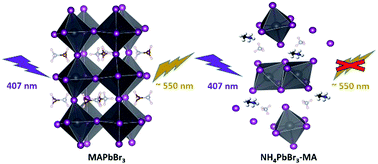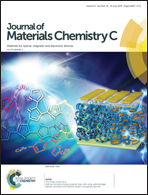An optical fibre-based sensor for the detection of gaseous ammonia with methylammonium lead halide perovskite†
Abstract
Highly fluorescent perovskite materials have attracted considerable interest for fundamental research and potential applications. In this work, we demonstrate the recoverable PL quenching of methylammonium lead halides (MAPbX3, where X is Cl, Br or I) upon exposure to gaseous ammonia that enables the use of hybrid perovskites in gas-sensing applications. XRD analysis confirmed that the MA cations in the perovskite material were replaced by NH3 to form NH4PbX3·MA, thereby resulting in distinct changes in the crystalline structure and, consequently, PL quenching. However, as a weak coordination complex, NH4PbX3·MA can be easily thermally decomposed to recover the starting product MAPbX3 with the release of ammonia. An in-depth understanding of the reversible chemical and structural changes of the perovskites by exposing them to polar molecules such as ammonia can advance the development of hybrid perovskite sensors and provides insights into the mechanisms of how perovskites coordinate with polar molecules.



 Please wait while we load your content...
Please wait while we load your content...